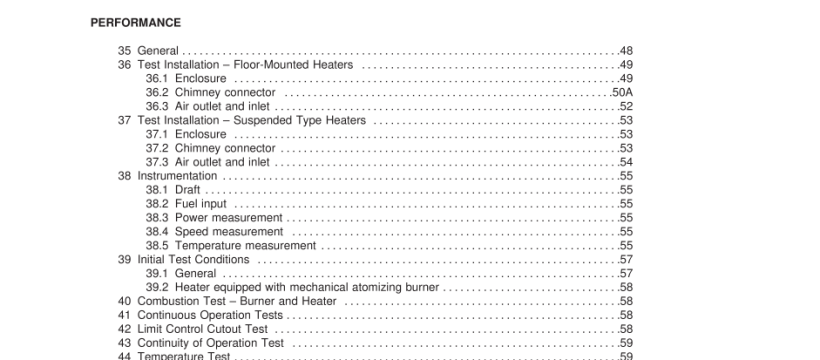UL 731-2009 pdf download.Oil-Fired Unit Heaters.
2.1 1 BURNER, MECHANICAL-ATOMIZING TYPE – A power-operated burner which prepares and delivers the oil and all or part of the air by mechanical process in controllable quantities for combustion. Some examples are air atomizing, high and low pressure atomizing, horizontal rotary, vertical rotary atomizing, and vertical rotary wall-flame burners. 2.1 2 BURNER, MECHANICAL DRAFT TYPE – A burner which includes a power-driven fan, blower, or other mechanism as the principal means for supplying air for combustion. 2.1 3 BURNER, NATURAL DRAFT TYPE – A burner which depends principally upon the natural draft created in the flue to induce into the burner the air required for combustion. 2.1 4 BURNER, VAPORIZING TYPE – A burner consisting of an oil-vaporizing bowl or other receptacle to which liquid fuel may be fed in controllable quantities. The heat of combustion is used to vaporize the fuel, with provision for admitting air and mixing it with the oil vapor in combustible proportions. 2.1 5 CASING – An enclosure forming the outside of the appliance, no parts of which are likely to be subjected to intense heat. 2.1 6 CENTRAL HEATING APPLIANCE – A stationary indirect-fired vented appliance comprising the following classes: boilers, central furnaces, floor furnaces, and recessed heaters. A floor-mounted unit heater to be connected to a duct system is classified also as a central heating appliance. 2.1 7 CHIMNEY CONNECTOR – The pipe which connects a solid or liquid fuel burning appliance to a chimney. 2.1 8 COMBUSTIBLE MATERIAL – Combustible material as pertaining to materials adjacent to or in contact with heat-producing appliances, chimney connectors, vent connectors, and warm air ducts means material made of or surfaced with wood, compressed paper, plant fibers, or other material that will ignite and burn. Such material shall be considered as combustible even though flameproofed, fire retardant treated, or plastered.
2.1 9 COMBUSTION – As used herein, the rapid oxidation of fuel accompanied by the production of heat, or heat and light. Complete combustion of a fuel is possible only in the presence of an adequate supply of oxygen. 2.20 COMBUSTION CHAMBER – The portion of an appliance within which combustion occurs. 2.21 COMBUSTION (FLAME) SAFEGUARD – A safety combustion control. 2.22 CONSTANT-LEVEL VALVE – A device for maintaining within a reservoir a constant level of fuel for delivery to the burner. 2.23 CONTROL – A device designed to regulate the fuel, air, water, or electrical supply to the controlled equipment. It may be automatic, semiautomatic, or manual. 2.24 CONTROL, LIMIT – An automatic safety control responsive to changes in liquid level, pressure, or temperature used for limiting the operation of the controlled equipment. 2.25 CONTROL, SAFETY – Automatic controls (including relays, switches, and other auxiliary equipment used in conjunction therewith to form a safety control system) which are intended to prevent unsafe operation of the controlled equipment.
2.26 CONTROL, PRIMARY SAFETY – The automatic safety control intended to prevent abnormal discharge of oil at the burner in case of ignition failure or flame failure. 2.27 CONTROL, SAFETY COMBUSTION – A primary safety control responsive directly to flame properties. It senses the presence of flame and causes fuel to be shut off in event of flame failure. 2.28 DAMPER – A valve or plate for regulating draft or flow of flue gases. A damper is generally considered as being located on the downstream side of the combustion chamber, usually in a flue passage of the appliance or in the chimney connector. 2.29 DAMPER, AUTOMATICALLY OPERATED – A damper operated by an automatic control. 2.30 DAMPER, MANUALLY OPERATED – An adjustable damper manually set and locked in the desired position. 2.31 DRAFT REGULATOR – A device which functions to maintain a desired draft in the appliance by automatically reducing the chimney draft to the desired value. 2.32 ELECTRICAL CIRCUITS: a) High-Voltage Circuit – A circuit involving a potential of not more than 600 volts and having circuit characteristics in excess of those of a low-voltage circuit. b) Low-Voltage Circuit – A circuit involving a potential of not more than 30 volts alternating-current (42.4 peak or direct current) and supplied by a primary battery, a standard Class 2 transformer or other suitable transforming device, or a suitable combination of transformer and fixed impedance having output characteristics in compliance with what is required for a Class 2 transformer. A circuit derived from a source of supply classified as a high-voltage circuit, by connecting resistance in series with the supply circuit as a means of limiting the voltage and current, is not considered to be a low-voltage circuit. c) Safety Control Circuit – A circuit involving one or more safety controls.UL 731-2009 pdf download.
UL 731-2009 pdf download
